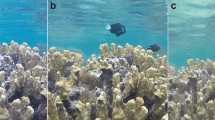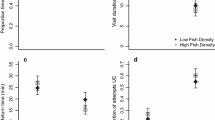Abstract
Animals balance feeding and anti-predator behaviors at various temporal scales. When risk is infrequent or brief, prey can postpone feeding in the short term and temporally allocate feeding behavior to less risky periods. If risk is frequent or lengthy, however, prey must eventually resume feeding to avoid fitness consequences. Species may exhibit different behavioral strategies, depending on the fitness tradeoffs that exist in their environment or across their life histories. North Pacific flatfishes that share juvenile rearing habitat exhibit a variety of responses to predation risk, but their response to risk frequency has not been examined. We observed the feeding and anti-predator behaviors of young-of-the-year English sole (Parophrys vetulus), northern rock sole (Lepidopsetta polyxystra), and Pacific halibut (Hippoglossus stenolepis)—three species that exhibit divergent anti-predator strategies—following exposure to three levels of predation risk: no risk, infrequent (two exposures/day), and frequent (five exposures/day). The English sole responded to the frequent risk treatment with higher feeding rates than during infrequent risk, following a pattern of behavioral response that is predicted by the risk allocation hypothesis; rock sole and halibut did not follow the predicted pattern, but this may be due to the limited range of treatments. Our observations of unique anti-predator strategies, along with differences in foraging and species-specific ecologies, suggest divergent trajectories of risk allocation for the three species.




Similar content being viewed by others
References
Blumstein DT, Bouskila A (1996) Assessment and decision making in animals: a mechanistic model underlying behavioral flexibility can prevent ambiguity. Oikos 77:569–576
Brown GE, Rive AC, Ferrari MCO, Chivers DP (2006) The dynamic nature of antipredator behavior: prey fish integrate threat-sensitive antipredator responses within background levels of predation risk. Behav Ecol Sociobiol 61:9–16
Dill LM (1987) Animal decision making and its ecological consequences: the future of aquatic ecology and behaviour. Can J Zool 65:803–811
Gibson RN, Robb L (1992) The relationship between body size, sediment grain size and the burying ability of juvenile plaice, Pleuronectes platessa L. J Fish Biol 40:771–778
Gill JL (1978) Design and analysis of experiments in the animal and medical sciences, vol 2. The Iowa State University Press, Ames, Iowa
Hamilton IM, Heithaus MR (2001) The effects of temporal variation in predation risk on anti-predator behaviour: an empirical test using marine snails. Proc R Soc Biol Sci Ser B 268:2585–2588
Hurst TP, Conover DO (2003) Seasonal and interannual variation in the allometry of energy allocation in juvenile striped bass. Ecology 84:3360–3369
Hurst TP, Abookire AA (2006) Temporal and spatial variation in potential and realized growth rates of age-0 year northern rock sole. J Fish Biol 68:905–919
Hurst TP, Ryer CH, Ramsey JM, Haines SA (2007) Divergent foraging strategies of three co-occurring north Pacific flatfishes. Marine Biology 151:1087–1098
Laurila A, Jarvi-Laturi M, Pakkasmaa S, Merila J (2004) Temporal variation in predation risk: stage-dependency, graded responses and fitness costs in tadpole antipredator defences. Oikos 107:90–99
Lemke JL, Ryer CH (2006a) Relative predation vulnerability of three juvenile (Age-0) North Pacific flatfish species: possible influence of nursery-specific predation pressures. Mar Ecol Prog Ser 328:267–273
Lemke JL, Ryer CH (2006b) Risk sensitivity in three juvenile (Age-0) flatfish species: does estuarine dependence promote risk-prone behavior? J Exp Mar Biol Ecol 333:172–180
Lima SL (1998) Nonlethal effects in the ecology of predator–prey interactions. Bioscience 48:25–34
Lima SL, Dill LM (1990) Behavioral decisions made under the risk of predation: a review and prospectus. Can J Zool 68:619–640
Lima SL, Bednekoff PA (1999) Temporal variation in danger drives antipredator behavior: the predation risk allocation hypothesis. Am Nat 153:649–659
Lima SL, Steury TD (2005) Perception of predation risk: the foundation of nonlethal predator–prey interactions. In: Barbosa P, Castellanos I (eds) Ecology of predator–prey interactions. Oxford University Press, New York, NY, pp 166–188
Mirza RS, Mathis A, Chivers DP (2006) Does temporal variation in predation risk influence the intensity of antipredator responses? a test of the risk allocation hypothesis. Ethology 112:44–51
Norcross BL, Muter F-J, Holladay BA (1997) Habitat models for juvenile pleuronectids around Kodiak Island, Alaska. Fish Bull 95:504–520
Pecor KW, Hazlett BA (2003) Frequency of encounter with risk and the tradeoff between pursuit and antipredator behaviors in crayfish: a test of the risk allocation hypothesis. Ethology 109:97–106
Pecor KW, Hazlett BA (2006) A test of temporal variation in risk and food stimuli on behavioral tradeoffs in the rusty crayfish, Orconectes rusticus: risk allocation and stimulus degradation. Ethology 112:230–237
Priede IG (1985) Metabolic scope in fishes. In: Tytler P, Calow P (eds) Fish energetics: new perspectives. The Johns Hopkins University Press, Baltimore, MD, pp 33–61
Ryer CH, Olla BL (1998) Shifting the balance between foraging and predator avoidance: the importance of food distribution for a schooling pelagic forager. Environ Biol Fishes 52:467–475
Ryer CH, Stoner AW, Titgen RH (2004) Behavioral mechanisms underlying the refuge value of benthic habitat structure for two flatfishes with differing anti-predator strategies. Mar Ecol Prog Ser 268:231–243
Ryer CH, Lemke JL, Boersma KS, Levas S (2008) Adaptive coloration, behavior and predation vulnerability in three juvenile north Pacific flatfishes. J Exp Mar Biol Ecol 359:62–66
Sih A, McCarthy TM (2002) Prey responses to pulses of risk and safety: testing the risk allocation hypothesis. Anim Behav 63:437–443
Sih A, Bell AM, Johnson JC, Ziemba RE (2004) Behavioral syndromes: an integrative overview. Q Rev Biol 79:241–277
Slos S, Stoks R (2006) Behavioural correlations may cause partial support for the risk allocation hypothesis in damselfly larvae. Ethology 112:143–151
Sokal RR, Rohlf FJ (1981) Biometry: the principles and practice of statistics in biological research. Freeman, San Francisco
Stoner AW, Ottmar ML (2003) Relationships between size-specific sediment preferences and burial capabilities in juveniles of two Alaska flatfishes. J Exp Mar Biol Ecol 282:85–101
Sundell J, Dudek D, Klemme I, Koivisto E, Pusenius J, Ylonen H (2004) Variation in predation risk and vole feeding behaviour: a field test of the risk allocation hypothesis. Oecologia 139:157–162
Swain DP, Morin R (1997) Effects of age, sex and abundance on the bathymetric pattern of American plaice in the southern Gulf of St Lawrence. J Fish Biol 50:181–200
Vainikka A, Jokelainen T, Kortet R, Ylonen H (2005) Predation risk allocation or direct vigilance response in the predator interaction between perch (Perca fluviatilis L.) and pike (Esox lucius L.). Ecol Freshw Fish 14:225–232
Van Buskirk J, Mueller C, Portmann A, Surbeck M (2002) A test of the risk allocation hypothesis: tadpole responses to temporal change in predation risk. Behav Ecol 13:526–530
Acknowledgments
We thank B. Laurel and two anonymous reviewers for their constructive comments on this manuscript. We are indebted to S. Haines, P. Iseri, J. Lemke, and M. Ottmar for laboratory and field assistance, and A. Abookire, E. Munk, M. Spencer, and T. Tripp for their help with fish collection. We also thank the many volunteers who assisted with fish collection in Yaquina Bay. This study was conducted as a component of the M.S. research of K.S.B. at Oregon State University. The work was funded by the North Pacific Research Board, grant #R0301 to C. Ryer, A. Abookire, I. Fleming, and A. Stoner. Additional assistance was provided to K.S.B. by Hatfield Marine Science Center’s Markham Scholarship. Experiments were conducted in accordance with the animal care protocols established by the National Marine Fisheries Service, Fisheries Behavioral Ecology Program, and all experiments complied with the current laws of the USA.
Author information
Authors and Affiliations
Corresponding author
Additional information
Communicated by K. Lindström
Rights and permissions
About this article
Cite this article
Boersma, K.S., Ryer, C.H., Hurst, T.P. et al. Influences of divergent behavioral strategies upon risk allocation in juvenile flatfishes. Behav Ecol Sociobiol 62, 1959–1968 (2008). https://doi.org/10.1007/s00265-008-0627-z
Received:
Revised:
Accepted:
Published:
Issue Date:
DOI: https://doi.org/10.1007/s00265-008-0627-z




